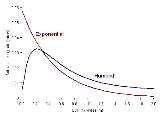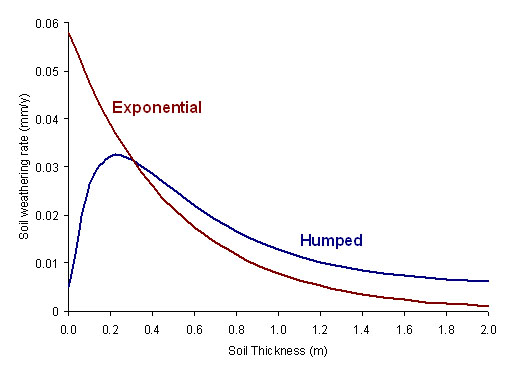
Soil production function
Encyclopedia

Bedrock
In stratigraphy, bedrock is the native consolidated rock underlying the surface of a terrestrial planet, usually the Earth. Above the bedrock is usually an area of broken and weathered unconsolidated rock in the basal subsoil...
weathering
Weathering
Weathering is the breaking down of rocks, soils and minerals as well as artificial materials through contact with the Earth's atmosphere, biota and waters...
into soil
Soil
Soil is a natural body consisting of layers of mineral constituents of variable thicknesses, which differ from the parent materials in their morphological, physical, chemical, and mineralogical characteristics...
as a function of soil thickness.
A general model suggested that the rate of physical weathering
Weathering
Weathering is the breaking down of rocks, soils and minerals as well as artificial materials through contact with the Earth's atmosphere, biota and waters...
of bedrock (de/dt) can be represented as an exponential decline with soil thickness:

where h is soil thickness [m], P0 [mm/year] is the potential (or maximum) weathering rate of bedrock and k [m−1] is an empirical constant.
The reduction of weathering rate with thickening of soil is related to the exponential decrease of temperature
Temperature
Temperature is a physical property of matter that quantitatively expresses the common notions of hot and cold. Objects of low temperature are cold, while various degrees of higher temperatures are referred to as warm or hot...
amplitude with increasing depth below the soil surface, and also the exponential decrease in average water penetration (for freely-drained soils). Parameters P0 and k are related to the climate
Climate
Climate encompasses the statistics of temperature, humidity, atmospheric pressure, wind, rainfall, atmospheric particle count and other meteorological elemental measurements in a given region over long periods...
and type of parent materials. found the value of P0 ranges from 0.08 to 2.0 mm/yr for sites in Northern California
Northern California
Northern California is the northern portion of the U.S. state of California. The San Francisco Bay Area , and Sacramento as well as its metropolitan area are the main population centers...
, and 0.05–0.14 mm/yr for sites in Southeastern Australia
Australia
Australia , officially the Commonwealth of Australia, is a country in the Southern Hemisphere comprising the mainland of the Australian continent, the island of Tasmania, and numerous smaller islands in the Indian and Pacific Oceans. It is the world's sixth-largest country by total area...
. Meanwhile values of k do not vary significantly, ranging from 2 to 4 m−1.
A number of landscape evolution model
Landscape evolution model
A landscape evolution model is a physically based numerical model that simulates changing terrain over the course of time. This can be due to glacial erosion and deposition; erosion, sediment transport, and deposition in fluvial systems such as rivers; regolith production; the movement of material...
s have adopted the so-called humped model. This model dates back to G.K. Gilbert's
Grove Karl Gilbert
Grove Karl Gilbert , known by the abbreviated name G. K. Gilbert in academic literature, was an American geologist....
Report on the Geology of the Henry Mountains (1877). Gilbert reasoned that the weathering
Weathering
Weathering is the breaking down of rocks, soils and minerals as well as artificial materials through contact with the Earth's atmosphere, biota and waters...
of bedrock was fastest under an intermediate thickness of soil and slower under exposed bedrock or under thick mantled soil. This is because chemical weathering
Weathering
Weathering is the breaking down of rocks, soils and minerals as well as artificial materials through contact with the Earth's atmosphere, biota and waters...
requires the presence of water. Under thin soil or exposed bedrock water tends to run off, reducing the chance of the decomposition of bedrock.

